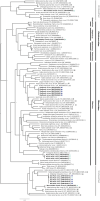Metagenomic Analysis of the Virome of Mosquito Excreta
- PMID: 32907949
- PMCID: PMC7485684
- DOI: 10.1128/mSphere.00587-20
Metagenomic Analysis of the Virome of Mosquito Excreta
Abstract
Traditional screening for arboviruses in mosquitoes requires a priori knowledge and the utilization of appropriate assays for their detection. Mosquitoes can also provide other valuable information, including unexpected or novel arboviruses, nonarboviral pathogens ingested from hosts they feed on, and their own genetic material. Metagenomic analysis using next-generation sequencing (NGS) is a rapidly advancing technology that allows us to potentially obtain all this information from a mosquito sample without any prior knowledge of virus, host, or vector. Moreover, it has been recently demonstrated that pathogens, including arboviruses and parasites, can be detected in mosquito excreta by molecular methods. In this study, we investigated whether RNA viruses could be detected in mosquito excreta by NGS. Excreta samples were collected from Aedes vigilax and Culex annulirostris experimentally exposed to either Ross River or West Nile viruses and from field mosquitoes collected across Queensland, Australia. Total RNA was extracted from the excreta samples, reverse transcribed to cDNA, and sequenced using the Illumina NextSeq 500 platform. Bioinformatic analyses from the generated reads demonstrate that mosquito excreta provide sufficient RNA for NGS, allowing the assembly of near-full-length viral genomes. We detected Australian Anopheles totivirus, Wuhan insect virus 33, and Hubei odonate virus 5 and identified seven potentially novel viruses closely related to members of the order Picornavirales (2/7) and to previously described, but unclassified, RNA viruses (5/7). Our results suggest that metagenomic analysis of mosquito excreta has great potential for virus discovery and for unbiased arbovirus surveillance in the near future.IMPORTANCE When a mosquito feeds on a host, it ingests not only its blood meal but also an assortment of microorganisms that are present in the blood, thus acting as an environmental sampler. By using specific tests, it is possible to detect arthropod-borne viruses (arboviruses) like dengue and West Nile viruses in mosquito excreta. Here, we explored the use of next-generation sequencing (NGS) for unbiased detection of RNA viruses present in excreta from experimentally infected and field-collected mosquitoes. We have demonstrated that mosquito excreta provide a suitable template for NGS and that it is possible to recover and assemble near-full-length genomes of both arboviruses and insect-borne viruses, including potentially novel ones. These results importantly show the direct practicality of the use of mosquito excreta for NGS, which in the future could be used for virus discovery, environmental virome sampling, and arbovirus surveillance.
Keywords: excreta; metagenomics; mosquito; next-generation sequencing; virome.
Copyright © 2020 Ramírez et al.
Figures




Similar articles
-
Metagenomic Virome Analysis of Culex Mosquitoes from Kenya and China.Viruses. 2018 Jan 12;10(1):30. doi: 10.3390/v10010030. Viruses. 2018. PMID: 29329230 Free PMC article.
-
Lack of abundant core virome in Culex mosquitoes from a temperate climate region despite a mosquito species-specific virome.mSystems. 2024 Jun 18;9(6):e0001224. doi: 10.1128/msystems.00012-24. Epub 2024 May 14. mSystems. 2024. PMID: 38742876 Free PMC article.
-
Mosquito-Borne Viruses and Insect-Specific Viruses Revealed in Field-Collected Mosquitoes by a Monitoring Tool Adapted from a Microbial Detection Array.Appl Environ Microbiol. 2019 Sep 17;85(19):e01202-19. doi: 10.1128/AEM.01202-19. Print 2019 Oct 1. Appl Environ Microbiol. 2019. PMID: 31350319 Free PMC article.
-
The virome of vector mosquitoes.Curr Opin Virol. 2021 Aug;49:7-12. doi: 10.1016/j.coviro.2021.04.002. Epub 2021 May 12. Curr Opin Virol. 2021. PMID: 33991759 Review.
-
Mosquito-borne arboviruses in Uganda: history, transmission and burden.J Gen Virol. 2021 Jun;102(6). doi: 10.1099/jgv.0.001615. J Gen Virol. 2021. Retraction in: J Gen Virol. 2021 Oct;102(10). doi: 10.1099/jgv.0.001679. PMID: 34166178 Retracted. Review.
Cited by
-
The use of molecular xenomonitoring for surveillance of mosquito-borne diseases.Philos Trans R Soc Lond B Biol Sci. 2021 Feb 15;376(1818):20190816. doi: 10.1098/rstb.2019.0816. Epub 2020 Dec 28. Philos Trans R Soc Lond B Biol Sci. 2021. PMID: 33357052 Free PMC article. Review.
-
Building a pathway to One Health surveillance and response in Asian countries.Sci One Health. 2024 Apr 2;3:100067. doi: 10.1016/j.soh.2024.100067. eCollection 2024. Sci One Health. 2024. PMID: 39077383 Free PMC article. Review.
-
Insect-specific virus platforms for arbovirus vaccine development.Front Immunol. 2025 Mar 14;16:1521104. doi: 10.3389/fimmu.2025.1521104. eCollection 2025. Front Immunol. 2025. PMID: 40160816 Free PMC article. Review.
-
Novel Virus Identification through Metagenomics: A Systematic Review.Life (Basel). 2022 Dec 7;12(12):2048. doi: 10.3390/life12122048. Life (Basel). 2022. PMID: 36556413 Free PMC article. Review.
-
Diversity and evolution of the animal virome.Nat Rev Microbiol. 2022 Jun;20(6):321-334. doi: 10.1038/s41579-021-00665-x. Epub 2022 Jan 4. Nat Rev Microbiol. 2022. PMID: 34983966 Review.
References
-
- Coffey LL, Page BL, Greninger AL, Herring BL, Russell RC, Doggett SL, Haniotis J, Wang C, Deng X, Delwart EL. 2014. Enhanced arbovirus surveillance with deep sequencing: identification of novel rhabdoviruses and bunyaviruses in Australian mosquitoes. Virology 448:146–158. doi:10.1016/j.virol.2013.09.026. - DOI - PMC - PubMed
Publication types
MeSH terms
Grants and funding
LinkOut - more resources
Full Text Sources
Medical

